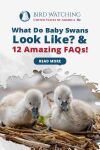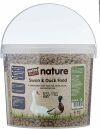
What’s This Post About?
Unlike many other baby birds, baby swans are one of the cutest and silliest beings to walk this earth. Their behavior and personality are unlike any other waddling across the fields following the mother swan. They’re found where their mothers are.
All the walking and waddling don’t tire out these small fluff balls. Baby swans are entirely different from adult swans as they don’t have much to worry or think about; all they do is follow their mother around.
Young swans or baby swans are born with dusky brown fuzzy feathers covering their entire bodies with a solid gray-black bill. Their leg color varies from grey to black and sometimes even yellowish to dusky brown, depending on the species of swan.

All About Baby Swans

Have you ever seen a mother swan with baby swans following in a line in a field of grass shallow lake? If so, the sight must’ve left you feeling everything that you can on the cute spectrum. They are tiny and use their small feet to walk around, following the mother.
They’re doing just about anything their mother is partaking in, which is adorable and hard not to find incredibly silly and adorable.
Continue reading the post if you’re interested in finding answers to some of the most frequently asked questions about these little waddlers!
What Are Baby Swans Called?

Baby swans are called cygnets—pronounced as sig-nets. These young birds appear short-necked and heavily covered in down feathers forming a thick fuzz around their bodies. They can run and swim, but they’re still relatively weaker and need a parent swan to look after them till they grow into healthy swans.
FUN FACT
Swans can hatch about ten eggs at one time.
What Is The Habitat Of Baby Swans?

Baby swans are found where their mothers are. Although the answer to this question is obvious, it still is essential to know that they’ll only be found where their mothers are. Swans inhabit some regions of Australia, New Zealand, South America, the United States, Canada, and Alaska.
They’re primarily found in areas with large water bodies because swans love to swim more than any other bird.
DID YOU KNOW?
Although swans and other water birds can live on the same pond in harmony, swans may get territorial and chase others away if a pond is too small.
What Is The Size Of A Baby Swan?

You’ll be filled with nothing but love for these little creatures after learning about their weight. A baby swan weighs about 250 grams; that’s equivalent to the weight of a block of butter. As they grow up and reach the age of six months, they weigh around 6 kg.
How Long Does It Take For Them Mature?

Cygnets stay with their parents for a long time, even when they’re fully capable of exploring the area and navigating boundaries independently. It takes roughly about six months for them to reach maturity. That’s when they’re full-grown adults ready to leave their mothers’ side and join a flock.
FUN FACT
At the age of six weeks, cygnets start to grow proper feathers.
How Long Do Baby Swans Stay With Their Parents?

Baby swans are entirely dependent on their mother for everything, from food to protection; the mother looks after every little detail. Once cygnets are all grown up and are six months of age, they leave their mothers’ side and join other flocks.
When a cygnet isn’t leaving the mother’s side, they’re usually shooed away by the mother, making them leave and join others in the flock.
FUN FACT
Some people are deathly afraid of swans. The fear of swans is called cygnophobia or kiknophobia.
What Do Baby Swans Eat?

Baby swans have weaker stomachs and smallmouths through which they can only consume softer foods. Cygnets will eat wheat and corn when thrown in water. Other than that, cygnets can also consume vegetable matter, water plants, and insects on their own by pecking on them repeatedly.
If you have a pet swan with little cygnets, what you can do is offer them the same food that you would normally give to your pet swan, except what you can do differently is soak it in water first. Explore this filling swan food option which you can purchase to give to the little cygnets.
Extra Select Premium Floating Swan and Duck Feed, 5 Litre
Excellent supplement for all Ducks, Swans, Waterfowl, Cranes, and Softbills.
Are Baby Swans Weak?

Although there is no reason to make a sweeping statement here about baby swans’ health, as a bird enthusiast, you must know that there is a 50% mortality rate of young cygnets which means that deaths occur quite frequently when cygnets first hatch from their eggs.
DID YOU KNOW?
Baby swans are precocial in nature, which means that these swanlings are mature from the moment they are born but still depend on parents to provide them with warmth.
Are Baby Swans Black Or White?

Baby swans are often seen surrounding a parent swan trying to take in as much warmth as they can as they all snuggle together closely.
These ducklings don’t look like their parents, and that is probably because the parent swans have a coat of mature feathers on them, whereas their babies are covered in down feathers.
Baby swans are neither born black nor white, and they have a dull brown fuzz covering their entire bodies, so it is safe to say that they lie somewhere in between. They are typically silvery-gray with a hint of brown found in most species of baby swans.
The hatchlings are initially brown, but they start growing mature feathers within six weeks, turning white as they get older. However, most adult swans are white, but there are also black ones or mixed ones (black-necked swan).
FUN FACT
A group of swans is called a bevy.
Can Baby Swans Survive On Their Own?

Although baby swans are precocial and independent, they still rely heavily on the warmth from their parents’ bodies to help them regulate their body temperature. Without the heat from their bodies, they would eventually die off.
A baby swan cannot survive on their own, at least not within the first two months of being born, since their bodies are weak and do not know much about looking for food or shelter. They need to learn these things from their parents.
Can You Keep Baby Swan As A Pet?

Baby swans are small and cute, which would make anyone with a heart wonder if they can keep these tiny fuzz balls as pets; the answer is yes. Baby swans can be kept as pets, but it’s not easy to raise a baby swan.
Swans thrive best in an environment that provides enough landscape to explore and a water body in which they can swim and float around. Therefore, you mustn’t take their wildlife experiences away from them when you decide upon keeping them as pets.
Swans as pets are quite different because they don’t exactly act like how a cat or dog would. Their nature is aggressive and unpredictable when they get territorial, so you will not know what to do when it’s time for them to nest or lay eggs.
What Do Albino/Leucistic Baby Swans Look Like?
Typically, an albino bird has white feathers covering its entire body with pink eyes, feet, and pale beaks. And a leucistic bird has some pigment in it and isn’t entirely white; in fact, it only lacks color in some parts of its body.
Albino baby swans do not survive as they generally are weaker and far smaller than regular babies. But if you look at the mortality rate of baby swans mentioned before, you’ll notice that it is already difficult for baby swans to survive, which is why an albino baby swan wouldn’t survive that long after hatching.
Leucistic swans have been spotted because the mutation doesn’t affect their overall health and the bird can survive easily compared to albino swans.
Can Baby Swans Fly?

Baby swans do not immediately start flying when they are born because the down feathers covering their entire body do not allow that to happen. As the cygnet reaches the age of about three months, it starts to develop mature feathers.
The mature feathers that it grows help the bird take its first flight without the assistance of its parents. Once they learn how to fly, there is very little need to be taken care of by their parents.

Keep Reading!
How adorable are these baby swans? They get on their feet the minute they hatch from their eggs and start wadding about following their mother any chance they get.
The young swans are pampered by both their parents for a long time, relatively longer than other birds, climbing on top of their parents and snuggling with them till they’re fully grown.
Growing up is a slow process for these little ones; the cygnets take some time to take the same appearance as their parents, but they do get there in a matter of months. Due to this, we can easily recognize the young swans that have just matured.
Swans are an interesting species having quirky habits which aren’t easy to keep track of; they’re unpredictable and equally beautiful. To learn more about other baby birds, read through this blog to learn what do baby hummingbirds look like.
What Do Baby Hummingbirds Look Like? [12 Pictures!]
Do you ever wonder what hummingbird babies look like? All necessary information with pictures is in this post.

By David A. Swanson
Bird Watching USA
My name is David and I'm the the founder of Bird Watching USA! I started Bird Watching with My father-in-law many years ago, and I've become an addict to watching these beautiful creatures. I've learnt so much over about bird watching over the years that I want to share with the world everything I know about them!

David A. Swanson
Bird Watching USA
My name is David and I'm the the founder of Bird Watching USA! I started Bird Watching with My father-in-law many years ago, and I've become an addict to watching these beautiful creatures. I've learnt so much over about bird watching over the years that I want to share with the world everything I know about them!




